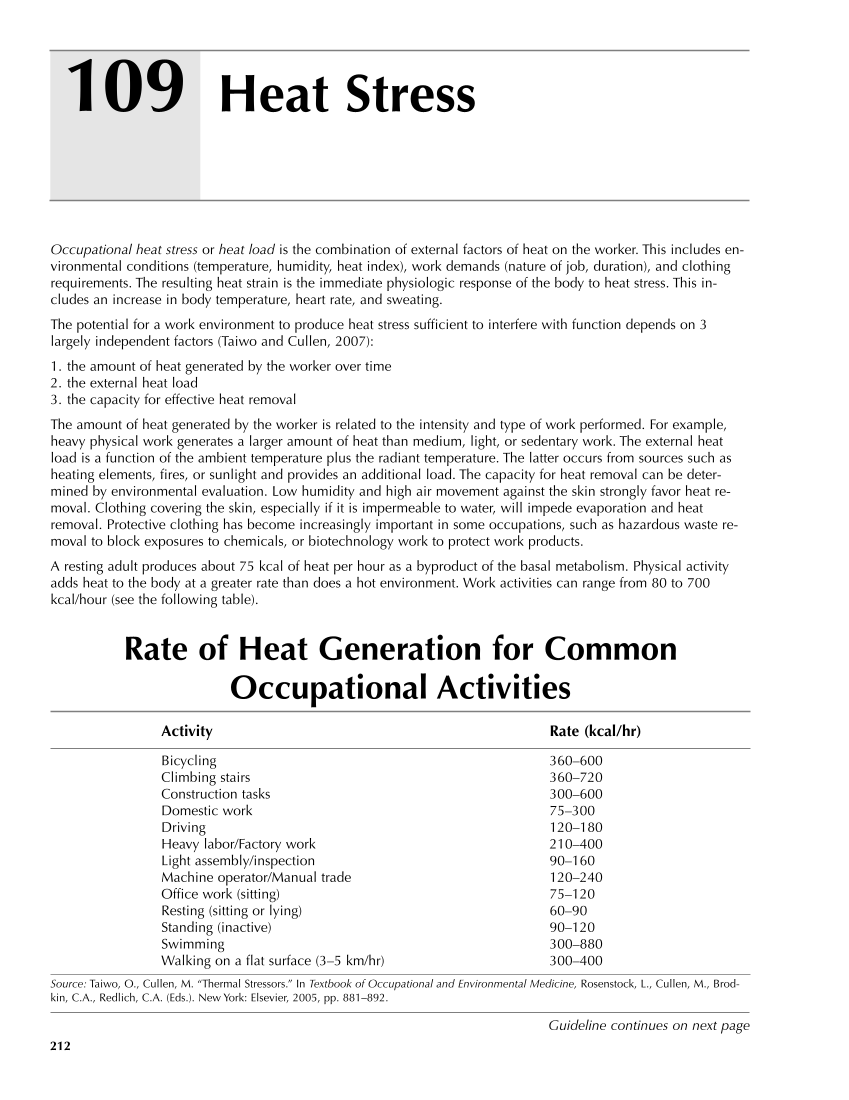109 212 Occupational heat stress or heat load is the combination of external factors of heat on the worker. This includes en- vironmental conditions (temperature, humidity, heat index), work demands (nature of job, duration), and clothing requirements. The resulting heat strain is the immediate physiologic response of the body to heat stress. This in- cludes an increase in body temperature, heart rate, and sweating. The potential for a work environment to produce heat stress sufficient to interfere with function depends on 3 largely independent factors (Taiwo and Cullen, 2007): 1. the amount of heat generated by the worker over time 2. the external heat load 3. the capacity for effective heat removal The amount of heat generated by the worker is related to the intensity and type of work performed. For example, heavy physical work generates a larger amount of heat than medium, light, or sedentary work. The external heat load is a function of the ambient temperature plus the radiant temperature. The latter occurs from sources such as heating elements, fires, or sunlight and provides an additional load. The capacity for heat removal can be deter- mined by environmental evaluation. Low humidity and high air movement against the skin strongly favor heat re- moval. Clothing covering the skin, especially if it is impermeable to water, will impede evaporation and heat removal. Protective clothing has become increasingly important in some occupations, such as hazardous waste re- moval to block exposures to chemicals, or biotechnology work to protect work products. A resting adult produces about 75 kcal of heat per hour as a byproduct of the basal metabolism. Physical activity adds heat to the body at a greater rate than does a hot environment. Work activities can range from 80 to 700 kcal/hour (see the following table). Rate of Heat Generation for Common Occupational Activities Activity Rate (kcal/hr) Bicycling 360–600 Climbing stairs 360–720 Construction tasks 300–600 Domestic work 75–300 Driving 120–180 Heavy labor/Factory work 210–400 Light assembly/inspection 90–160 Machine operator/Manual trade 120–240 Office work (sitting) 75–120 Resting (sitting or lying) 60–90 Standing (inactive) 90–120 Swimming 300–880 Walking on a flat surface (3–5 km/hr) 300–400 Source: Taiwo, O., Cullen, M. “Thermal Stressors.” In Textbook of Occupational and Environmental Medicine, Rosenstock, L., Cullen, M., Brod- kin, C.A., Redlich, C.A. (Eds.). New York: Elsevier, 2005, pp. 881–892. Heat Stress Guideline continues on next page
Purchased from OEM Press by (ge corporate access). (C) 2013 OEM Health Information, Inc. All rights reserved.












































































































































































































































































































































































































































